-
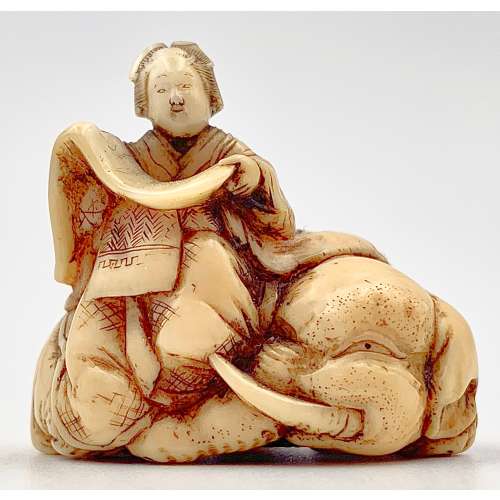 Netsuke of Kimi no Eguchi on a recumbent elephant. Signed: Toun. Circa 1850. 33.7 x 30.8 x 22.7 mm. The Courtesan Eguchi no kimi as Fugen, Bodhisattva of Universal Wisdom (Eguchi no kimi mitate Fugen Bosatsu). The imagery satirizes the Buddhist bodhisattva Fugen, whose iconographic mount is an elephant, by replacing the deity with a beautifully coiffed modern courtesan. Such a visual pun (mitate) was an artistic trope, popular in the Edo period. Provenance: Charles Ephrussi (1849-1905) acquired in the 1870s; a wedding gift in 1898 to his cousin Ritter Viktor von Ephrussi (1860-1945) and Baroness Emilie (Emmy) Schey von Koromla (1879-1938); retrieved post-war by their daughter Elizabeth de Waal (1899-1991); given by her to her brother Ignaz (Iggie) Ephrussi (1906-1994), Tokyo; bequeathed by him to his great-nephew Edmund de Waal (born 1964), London, author of "The Hare with Amber Eyes: a hidden inheritance". London / New York: Chatto & Windus / Farrar, Straus & Giroux. ISBN 978-0099539551. https://en.wikipedia.org/wiki/Charles_Ephrussi. https://en.wikipedia.org/wiki/Ephrussi_family. https://en.wikipedia.org/wiki/Edmund_de_Waal.
Netsuke of Kimi no Eguchi on a recumbent elephant. Signed: Toun. Circa 1850. 33.7 x 30.8 x 22.7 mm. The Courtesan Eguchi no kimi as Fugen, Bodhisattva of Universal Wisdom (Eguchi no kimi mitate Fugen Bosatsu). The imagery satirizes the Buddhist bodhisattva Fugen, whose iconographic mount is an elephant, by replacing the deity with a beautifully coiffed modern courtesan. Such a visual pun (mitate) was an artistic trope, popular in the Edo period. Provenance: Charles Ephrussi (1849-1905) acquired in the 1870s; a wedding gift in 1898 to his cousin Ritter Viktor von Ephrussi (1860-1945) and Baroness Emilie (Emmy) Schey von Koromla (1879-1938); retrieved post-war by their daughter Elizabeth de Waal (1899-1991); given by her to her brother Ignaz (Iggie) Ephrussi (1906-1994), Tokyo; bequeathed by him to his great-nephew Edmund de Waal (born 1964), London, author of "The Hare with Amber Eyes: a hidden inheritance". London / New York: Chatto & Windus / Farrar, Straus & Giroux. ISBN 978-0099539551. https://en.wikipedia.org/wiki/Charles_Ephrussi. https://en.wikipedia.org/wiki/Ephrussi_family. https://en.wikipedia.org/wiki/Edmund_de_Waal. -

Iron tsuba of round form pierced (sukashi) and inlaid in flat (hira-zōgan) and cast brass (suemon-zōgan), details carved in kebori, with design of two phoenixes, bamboo, and paulownia leaves and flowers (kiri-mon) on both sides. According to seller: Bizen-Yoshirō school (or Heianjō school). Unsigned.
Momoyama period. End of the 16th - beginning of the 17th century. Dimensions: Diameter: 99.5 mm; Thickness: 2.1 mm at centre; 4.3 mm at the rim. According to Merrily Baird (Symbols of Japan), "bamboo teamed with paulownia blossoms or with paulownia and the phoenix, in reference to the Chinese legend that the phoenix perches only on the paulownia and eats only the bamboo". Citation from http://www.clevelandart.org/art/1986.2.1: "The immense heraldic birds on display [...] reflect the Momoyama era's spirit of newly gained self-confidence and an affinity for grand expressive statements in painting, architecture, the textile and ceramic arts, as well as garden design. While that period preceded the arrival of prosperity, it clearly marked an extraordinary moment in Japanese cultural history, one frequently compared with the twelfth century of the Heian period. [...] Rather than an emblem of immortality, as it is in Western lore, in Japan, the phoenix evolved out of its origins in Chinese mythology to become, by the sixteenth century, an auspicious symbol of political authority. Together with clusters of the distinctively shaped paulownia leaves, this long-tailed, mythical bird [...] proclaiming an air of graceful command". -
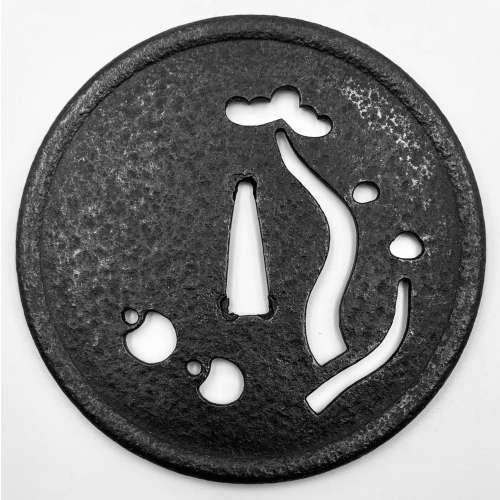
Iron tsuba of circular form with design of pine trees (matsu) and monkey toys (kukurizaru) in openwork (ko-sukashi). Ko-Katchushi school.
Raised rim (mimi) with iron bones (tekkotsu). Size: Diameter: 99.5 mm; Thickness: 2.1 mm at centre; 4.3 mm at the rim.Early Muromachi period: 15th century (Kakitsu - Bun'an era, 1441 - 1449).
-
 Untrimmed fan print (uchiwa-e), 231 x 300 mm. Title: A geisha eating edamame aboard the boat of the Atari-ya teahouse. Series: Three summer women [九夏三婦久] (Kyūka sanfuku). Artist: Utagawa Kunisada [歌川 国貞] a.k.a. Utagawa Toyokuni III [三代歌川豊国] (Japanese, 1786 – 1865). Artist: Utagawa Kunihisa II [歌川国久] a.k.a. Katsuda Hisatarō, Ichiunsai, Ritchōrō, Toyonobu, Yōryūsai, Yōsai] (Japanese, 1832 – 1981). Block cutter: Yokokawa Horitake [横川彫武] a.k.a. Yokokawa Takejiro [横川竹二郎] (Japanese, fl. 1860s). Publisher: Ibaya Senzaburō [伊場屋仙三郎] (Japanese, fl. C. 1845 – 1847) Combined date seal and kiwame censor seal: 1860 (Ansei 7 / Man'en 1 from 18/III). Signed: Toyokuni ga in toshidama cartouche, and Kunihisa ga. Provenance: The Collection of Paul F. Walter, Christie's, New York, 2017, lot 341; sol together with 5 other fan prints for $25,000. Before: Israel Goldman, Japanese Prints, Catalogue 9, 2003, no. 35. Ref: [LIB-1693.2018] The Collection of Paul Walter. — NY: Christie's, 2017, p. 363. Ref: Israel Goldman, Catalogue 2018, № 52: "Utagawa Kunisada (1786-1865) and Utagawa Kunihisa II (1832-1891) A Geisha Eating Edamame Aboard the Boat of the Atari-ya Teahouse. From the series Kyuka sanfuku (Three Summer Women). 1860. Fan print. 22.7 x 29.6 cm. Provenance: Israel Goldman, Japanese Prints, Catalogue 9, 2003, no. 35. The Collection of Paul F. Walter, Christies, New York, 201, lot 341. Fine impression, colour and condition. The title is a pun on “kyuka sanpuku” meaning the hottest point of the summer. The background view is by Kunisada’s pupil Kunihisa."
Untrimmed fan print (uchiwa-e), 231 x 300 mm. Title: A geisha eating edamame aboard the boat of the Atari-ya teahouse. Series: Three summer women [九夏三婦久] (Kyūka sanfuku). Artist: Utagawa Kunisada [歌川 国貞] a.k.a. Utagawa Toyokuni III [三代歌川豊国] (Japanese, 1786 – 1865). Artist: Utagawa Kunihisa II [歌川国久] a.k.a. Katsuda Hisatarō, Ichiunsai, Ritchōrō, Toyonobu, Yōryūsai, Yōsai] (Japanese, 1832 – 1981). Block cutter: Yokokawa Horitake [横川彫武] a.k.a. Yokokawa Takejiro [横川竹二郎] (Japanese, fl. 1860s). Publisher: Ibaya Senzaburō [伊場屋仙三郎] (Japanese, fl. C. 1845 – 1847) Combined date seal and kiwame censor seal: 1860 (Ansei 7 / Man'en 1 from 18/III). Signed: Toyokuni ga in toshidama cartouche, and Kunihisa ga. Provenance: The Collection of Paul F. Walter, Christie's, New York, 2017, lot 341; sol together with 5 other fan prints for $25,000. Before: Israel Goldman, Japanese Prints, Catalogue 9, 2003, no. 35. Ref: [LIB-1693.2018] The Collection of Paul Walter. — NY: Christie's, 2017, p. 363. Ref: Israel Goldman, Catalogue 2018, № 52: "Utagawa Kunisada (1786-1865) and Utagawa Kunihisa II (1832-1891) A Geisha Eating Edamame Aboard the Boat of the Atari-ya Teahouse. From the series Kyuka sanfuku (Three Summer Women). 1860. Fan print. 22.7 x 29.6 cm. Provenance: Israel Goldman, Japanese Prints, Catalogue 9, 2003, no. 35. The Collection of Paul F. Walter, Christies, New York, 201, lot 341. Fine impression, colour and condition. The title is a pun on “kyuka sanpuku” meaning the hottest point of the summer. The background view is by Kunisada’s pupil Kunihisa." -
 Utagawa Toyokuni I (歌川豐國); 1769 – 24 February 1825. Kabuki actor Onoe Matsusuke I (other stage names: Onoe Shôroku I and Onoe Tokuzô) lived from 1744 (born in Edo, present Tokyo) until the 16th day of the 10th lunar month of 1815 (died in Edo). Here he plays the honourable villain, the powerful minister of state Kudō Saemon Suketsune. Kabuki actor Bandô Hikosaburô III (other stage names: Ichimura Kichigorô I, other names: Hansôan Rakuzen, Bandô Shinsui III, and Rakuzenbô) lived from 1754 (born in Edo, present Tokyo) until 18th day of the 2nd lunar month of 1828. "1813 ~ 1828: Hikosaburô retires and takes the tonsure in a Temple located in Kurodani (Kyôto). He goes back to Edo and lives a hermit life in a small hut called Hansôan and located in Mukôjima." Here he plays Soga no Gorō Tokimune, the younger of two Soga brothers. It was an Edo period custom to produce every New Year's a play in which the Soga brothers figured. The Sogas were actual historical figures who, in 1193, avenged their father's murder by staging a daring night raid on their enemy during a grand hunt. The villain, a powerful minister of state named Kudō Saemon Suketsune, had orchestrated the murder of their father seventeen years earlier. The exact play, theater, and year featured on the print are not currently known. Publisher: AM-23-016 |391q: Nishimuraya Yohachi: Eiju han 1780s-1809 [AM: Andreas Marks. Publishers of Japanese woodblock prints: A compendium. Hotei Publishing, Leiden-Boston, 2011]. References:
Utagawa Toyokuni I (歌川豐國); 1769 – 24 February 1825. Kabuki actor Onoe Matsusuke I (other stage names: Onoe Shôroku I and Onoe Tokuzô) lived from 1744 (born in Edo, present Tokyo) until the 16th day of the 10th lunar month of 1815 (died in Edo). Here he plays the honourable villain, the powerful minister of state Kudō Saemon Suketsune. Kabuki actor Bandô Hikosaburô III (other stage names: Ichimura Kichigorô I, other names: Hansôan Rakuzen, Bandô Shinsui III, and Rakuzenbô) lived from 1754 (born in Edo, present Tokyo) until 18th day of the 2nd lunar month of 1828. "1813 ~ 1828: Hikosaburô retires and takes the tonsure in a Temple located in Kurodani (Kyôto). He goes back to Edo and lives a hermit life in a small hut called Hansôan and located in Mukôjima." Here he plays Soga no Gorō Tokimune, the younger of two Soga brothers. It was an Edo period custom to produce every New Year's a play in which the Soga brothers figured. The Sogas were actual historical figures who, in 1193, avenged their father's murder by staging a daring night raid on their enemy during a grand hunt. The villain, a powerful minister of state named Kudō Saemon Suketsune, had orchestrated the murder of their father seventeen years earlier. The exact play, theater, and year featured on the print are not currently known. Publisher: AM-23-016 |391q: Nishimuraya Yohachi: Eiju han 1780s-1809 [AM: Andreas Marks. Publishers of Japanese woodblock prints: A compendium. Hotei Publishing, Leiden-Boston, 2011]. References:- Kabuki Plays on Stage: Brilliance and Bravado, 1697-1766 (Kabuki Plays on Stage, Volume 1). Brandon, James R., Leiter, Samuel L. University of Hawai'I Press, Honolulu, 2002.
- Kabuki Encyclopedia. An English-Langauge Adaptation of Kabuki Jiten. Samuel L. Leiter. Greenwood Press, 1979.
- https://www.kabuki21.com/
-
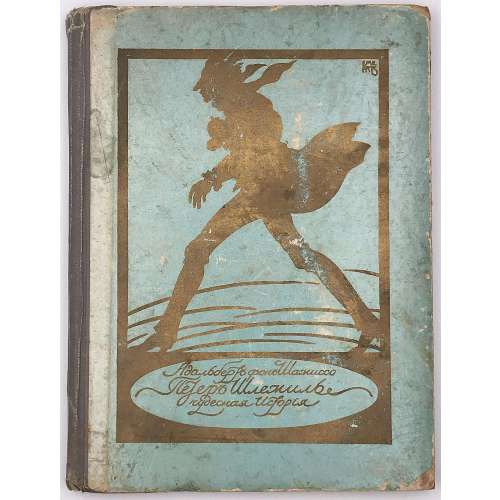
Шамиссо, Адальбертъ фонъ. Петеръ Шлемиль. Чудесная исторiя. Пер. П.Потемкина. Рис., виньетки и перепет Эмиля Преторiуса по 1-му нѣм. изд. 1814 г. — СПб.: Книгоиздательство "Пантеонъ", 1910. — 107 стр. Отпечатано в типографии акц. о-ва типографск. дела в СПБ (Герольд), 7 рота, 26.
Cardboard binding, 8vo, 20 x 15 cm. Russian translation of Adelbert von Chamisso book Peter Schlemihl, from the German by Peter Potemkine. With illustrations from 1814 original German first edition by Emil Preetorius. [SV: the latest statement seems strange as Emil Preetorius lived from 1883 to 1973]. -
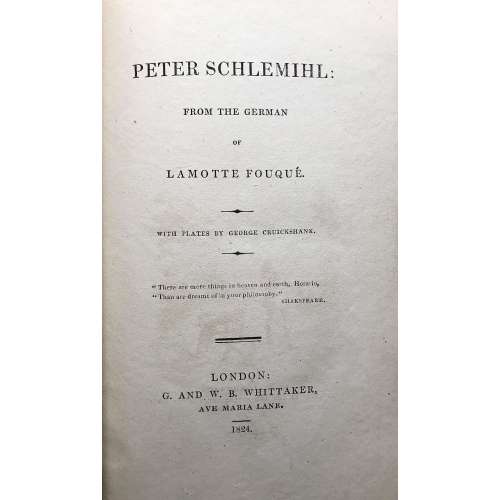 Title: PETER SCHLEMIHL: | FROM THE GERMAN | OF LAMOTTE FOUQUÉ | WITH PLATES BY GEORGE CRUICKSHANK. | "There are more things in heaven and earth, Horatio, | "Than are dreamt of in your philosophy." | SHAKESPEARE. | — | LONDON: | G. AND W. B. WHITTAKER, | AVE MARIA LANE. | 1824.|| Pagination: xii, 165 p. : ill. No Adelbert von Chamisso (German, 1781 – 1838) name on the title page. George Cruikshank's name printed with a typo 'Cruickshank'. The attribution on the title-page to Friedrich de La Motte-Fouqué (German, 1777 – 1843) is erroneous. The original German was edited by La Motte Fouqué. The translation was performed by Sir John Bowring (British, 1792 – 1872) First edition in English, third issue with no hyphen between "Ave" and 'Maria" in publisher's imprint.
Title: PETER SCHLEMIHL: | FROM THE GERMAN | OF LAMOTTE FOUQUÉ | WITH PLATES BY GEORGE CRUICKSHANK. | "There are more things in heaven and earth, Horatio, | "Than are dreamt of in your philosophy." | SHAKESPEARE. | — | LONDON: | G. AND W. B. WHITTAKER, | AVE MARIA LANE. | 1824.|| Pagination: xii, 165 p. : ill. No Adelbert von Chamisso (German, 1781 – 1838) name on the title page. George Cruikshank's name printed with a typo 'Cruickshank'. The attribution on the title-page to Friedrich de La Motte-Fouqué (German, 1777 – 1843) is erroneous. The original German was edited by La Motte Fouqué. The translation was performed by Sir John Bowring (British, 1792 – 1872) First edition in English, third issue with no hyphen between "Ave" and 'Maria" in publisher's imprint.In a cover box of red cloth over cardboard. Box: 21 x 13 x 2.3 cm; book: 19.3 x 11.8 x 1.7 cm; Crown 8vo. Red cardboard binding. Printed spine labels mounted on spine of the box and the book. Untrimmed edges.
Reference: Cohn 475. -
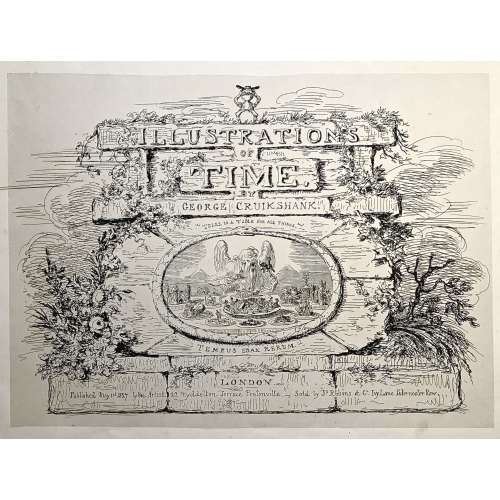
Engraved title page: ILLUSTRATION | OF | TIME. | GEORGE CRUIKSHANK. | "THERE IS A TIME FOR ALL THINGS". | TEMPUS EDAX RERUM. | LONDON | Published May 1st 1827 by the Artist - 22 Myddelton Terrace Pentonville. - Sold by Js. Robins & Co. Ivy Lane Paternoster Row.
Oblong folio, 33.5 x 44 cm. Engraved vignette title page and six not-coloured engraved plates with multiple images showing thirty-five humorous scenes.
First edition, first issue. Uncoloured. Pristine condition.
Half-leather bound in marbled cardboard and red morocco and gild lettering and arabesque. Frontispiece and 6 plates with protective tissues.
Content:1. Time-Called & Time-Come (five sketches)
2. Behind Time (seven sketches)
3. Time Thrown Away (six sketches)
4. Hard Times [&] Term Time (five sketches)
5. Time Badly Employed (five sketches)
6. Christmas Time (seven sketches)
British Museum № 1978,U.3026.1. BM description: "Frontispiece, the title on a background of symmetrical but dilapidated and grass-grown masonry. On the summit stands a little laughing gnome, with a wide hat and a body formed of an hour-glass; Inset is an oval bordered by a serpent with its tail in its mouth (emblem of eternity), in which is an aged and all-devouring Time (bald except for a forelock), seated behind a table whose surface is the base of the design. He puts to his mouth a fork on which is speared an elephant with a castle on its back containing tiny figures with spears. In his r. hand is a spoon containing a country church. His table is covered with dishes, and at his r. hand is a sickle. The central and biggest dish is heaped with a jumble of tiny objects: crown, table, chair, wheelbarrow, picture; round the room sit little figures: a soldier, parson, lady and child, &c. The ten other dishes contain: an antique glass coach with horses and footmen; an overladen camel beside a palm-tree; ruins of a castle; a farmhouse; a shepherd and sheep; a dismantled cannon and balls, cattle, a man-of-war in full sail; a ruinous Gothic cathedral; a clump of trees (the last two are dominated by a large decanter). Below Time are two (Egyptian) pyramids. Above: 'There Is A Time For All Things'; below: 'Tempus Edax Rerum'. 1 May 1827. Etching."Bibliography:- Reid, G W, A descriptive catalogue of the works of George Cruikshank, London, 1871.
- Stephens, Frederic George; George, Mary Dorothy, Catalogue of Political and Personal Satires in the Department of Prints and Drawings in the British Museum, 11 vols, London, BMP, 1870.
- Cohn, A M, George Cruikshank, catalogue raisonné, London, 1924.
-
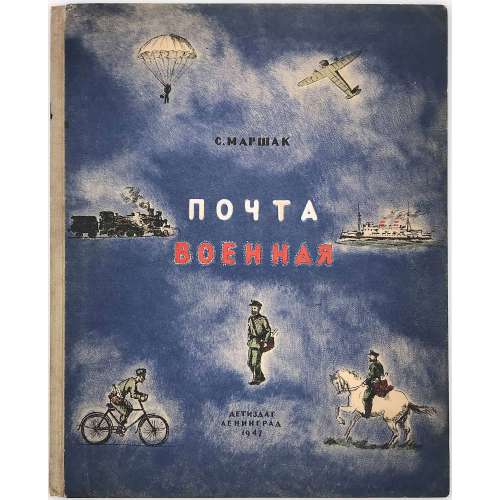 С. Маршак. Почта военная. Детиздат : Ленинград, 1947.
С. Маршак. Почта военная. Детиздат : Ленинград, 1947.Hard-bound Quatro (304 x 246 mm) printed in lithography with hand-colored details on cover.
The name of artist hardly legible on a stamp on frontispiece: скворцов.
The text repeats itself on multiple pages. Most probably the book is a pilot run, never went to mass printing and distribution. -
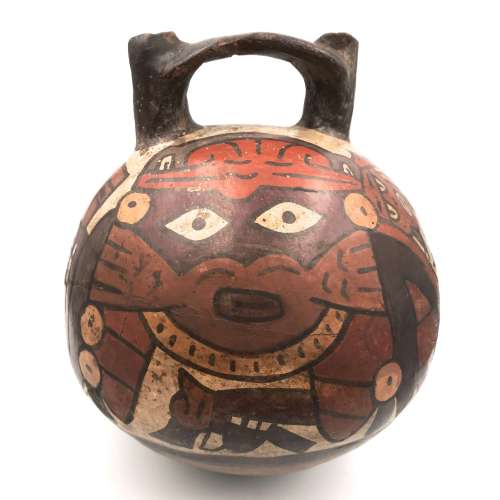
Pre-Columbian, South Coast of Peru, Nazca, ca.200 - 500 CE. Polychrome double-spout, or stir-up vessel (jar, or bottle), decorated on both sides with designs of anthropomorphic Mythical Spotted Cat (or the Cat Deity) with hand holding the club, a trophy head and spears.
Colors: Black, Cream, Gray, Orange, White, Dark Red (7 colors).
Size: Diameter 15.2 cm. References:- A Sourcebook of Nasca Ceramic Iconography: Reading a Culture through Its Art. Donald A. Proulx. University of Iowa Press, 2006; pp. 88-91. [LIB-1556].
- The Archaeology and Pottery of Nazca, Peru: Alfred Kroeber’s 1926 Expedition. Alfred L. Kroeber and Donald Collier, edited by Patrick H. Carmichael with an afterword by Katharina J. Schreiber. AltaMira Press in coop. with Field Museum, Chicago, Il., 1998; p.121. [LIB-1557].
-
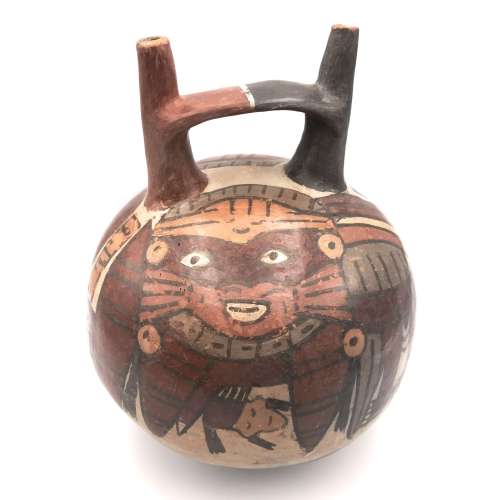
Pre-Columbian, South Coast of Peru, Nazca, ca. 400 - 600 CE. Polychrome double-spout, or stir-up vessel (jar, or bottle), decorated on both sides with designs of masked Mythical Spotted Cat (or the Cat Deity) with a trophy head. Colors: Black, Cream, Gray, Orange, White, Dark Red, Light Red (8 colors).
Size: 17.2 x 14 cm.
References:- A Sourcebook of Nasca Ceramic Iconography: Reading a Culture through Its Art. Donald A. Proulx. University of Iowa Press, 2006; pp. 88-91. [LIB-1556].
- The Archaeology and Pottery of Nazca, Peru: Alfred Kroeber’s 1926 Expedition. Alfred L. Kroeber and Donald Collier, edited by Patrick H. Carmichael with an afterword by Katharina J. Schreiber. AltaMira Press in coop. with Field Museum, Chicago, Il., 1998; p.121. [LIB-1557].
Ex Arte Xibalba, Florida; Ex Robert Dowling Gallery, San Francisco, CA.
-
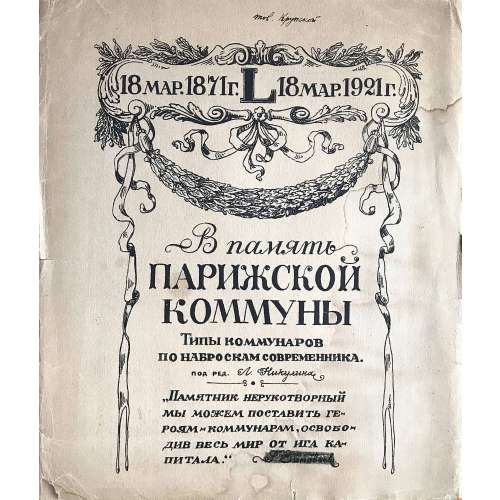
Unbound Quatro (246 x 321 mm) album in softcover with inscription:
В память Парижской коммуны. 18 мар. 1871 - 18 мар. 1921. L. Типы комунаров по наброскам современника. Под ред. Л. Никулина. "Памятник нерукотворный мы можем поставить героям-коммунарам, освободив весь мир от ига капитала." Г. Зиновьев.
Надписано от руки: Экз. тов. Крупской.
17 отпечатков с измененных литографий Берталя (без ссылки). Издание Политотдела Балтийского Флота и Петроградского губ. Отд. народн. Образования. Петроград.
Translation from Russian: In memory of the Paris Commune. March 18, 1871 - March 18, 1921. (L*). Types of the communards from the sketches of contemporaries. Edited by L. Nikulin. "Not-made-by-hand monument we will erect to the heroic Communards by freeing the world from the yoke of capital". G. Zinoviev. Handwritten inscription in black ink: Copy of (or for) comrade Krupskaya. The album consists of 17 unnumbered prints with captions in Russian. The prints are altered images made by Bertall, with no reference to the artist. The album is published by Political division of Baltic Navy and Petrograd district of public education. Printed in Petrograd (Saint Petersburg). *Roman letter L - Fifty (Fifty year anniversary) -
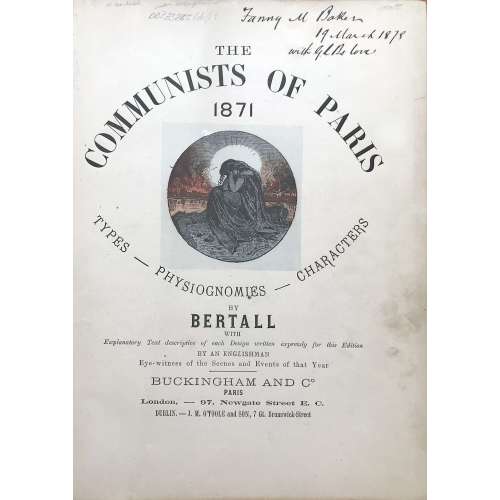 Folio (246 x 321 mm), hardbound in red-brown cloth with gilt lettering and decoration. Content, Introduction by J. E., September, 1873, Artist preface by Bertall, Paris, 1871-1873. Album with 40 hand-colored lithographs by Bertall, numbered 1 through 40, accompanied with extensive descriptions. Ex Libris: Baker. Carpe Diem. Markings: Janny M. Baker with J.L.B. Love, 19 March, 1878 in black ink.
Folio (246 x 321 mm), hardbound in red-brown cloth with gilt lettering and decoration. Content, Introduction by J. E., September, 1873, Artist preface by Bertall, Paris, 1871-1873. Album with 40 hand-colored lithographs by Bertall, numbered 1 through 40, accompanied with extensive descriptions. Ex Libris: Baker. Carpe Diem. Markings: Janny M. Baker with J.L.B. Love, 19 March, 1878 in black ink. -
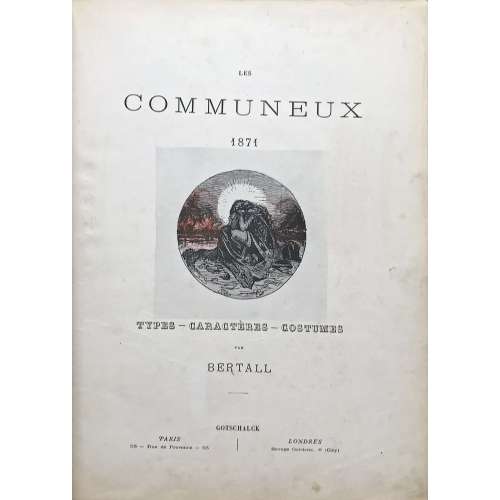 Folio (240 x 320 mm), hardbound in blue-aubergine cloth with gilt lettering and decoration. Album with Avant-Propos and 34 hand-colored lithographs by Bertall, numbered 1 through 34. Details in Russian: "Памяти парижской коммуны".
Folio (240 x 320 mm), hardbound in blue-aubergine cloth with gilt lettering and decoration. Album with Avant-Propos and 34 hand-colored lithographs by Bertall, numbered 1 through 34. Details in Russian: "Памяти парижской коммуны". -

Iron tsuba of round form with brown patina decorated with the design of a Buddhist temple bell (tsurigane) in openwork (sukashi), with details outlined in brass wire (sen-zōgan), the outer ring decorated with two rows of brass dots (ten-zōgan), and the bell details carved in sukidashi-bori as on kamakura-bori pieces.
Ōnin school. Unsigned. Late Muromachi period, 16th century. Dimensions: 88.8 x 88.3 x 3.0 mm. As per Merrily Baird, two legends are usually associated with the image of tsurigane, a large, suspended Buddhist bell: one is that of Dojo Temple (Dojo-ji), and the other is of Benkei stealing the tsurigane of Miidera Temple. Interestingly, this type of bell (tsurigane) is not described as a family crest (mon), while suzu and hansho bells are. -
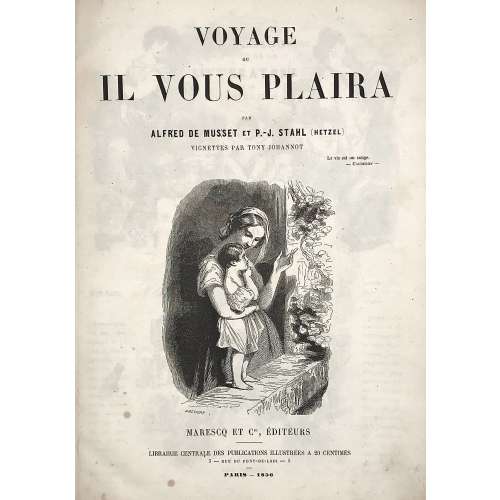
Voyage ou Il vous plaira by Alfred de Musset and P.-J. Stahl (Hetzel); Tony Johannot (illustrations). [Les chefs d'oeuvres de la litterature et de l'illustration] // Marescq et Cie, éditeurs, - Paris, 1856.
Contes de Charles Nodier by Jean Charles Emmanuel Nodier (1780 – 1844) illustrated by H. Émy.
Owner's binding in red half Morocco, A4 (297 x 219 mm). "Voyage ou Il vous plaira" (60 pages) and fairy tales by Charles Nodier with illustrations by H. Émy (Armand-Louis-Henri Telory, born in Strasbourg in 1820 and died in 1874): "La Fée aux miettes" ; "Le songe d'or (fable levantine)"; "La légende de la Soeur Béatrix"; "Trilby"; Inès de las Sierras"; "Baptiste Montauban"; "Smarra ou les démons de la nuit"; "La neuvaine de la Chandeleur"; "La combe de l’homme mort". Extensive foxing, owner's pencil drawings on some pages, otherwise good condition.
-
 Le Petit Chaperon rouge (Little Red Riding Hood), three wood engravings by Gustave Doré, 1864: "En passant dans un bois elle rencontra compère le Loup"; "Le Chaperon rouge fut bien étonné de voir comment sa grand'mère était faite en son déshabillé"; "Cela n'empêche pas qu'avec ses gran dents il avait mangé une bonne grand'mère". Engraved by Adolphe Pannemaker. Le Petit Poucet (Little Thumb), one wood engraving by Gustave Doré, 1864: "Une bonne femme vint leur ouvrir". Engraved by Héliodore-Joseph Pisan. La Belle au bois dormant (Sleeping Beauty), one wood engraving by Gustave Doré, 1864: "Il marcha vers le château qu'il voyait au bout d'une grande avenue où il entra". Engraved by Héliodore-Joseph Pisan. Medium: Paper; Wood engraving. Illustrations for P.-J. Hetzel's edition of Perrault's Fairy Tales (Les Contes de Perrault) by Gustave Doré published in 1864. Size: frame: 428 x 302 mm; sheet: 280 x 231 mm; image: 194 x 244 mm.
Le Petit Chaperon rouge (Little Red Riding Hood), three wood engravings by Gustave Doré, 1864: "En passant dans un bois elle rencontra compère le Loup"; "Le Chaperon rouge fut bien étonné de voir comment sa grand'mère était faite en son déshabillé"; "Cela n'empêche pas qu'avec ses gran dents il avait mangé une bonne grand'mère". Engraved by Adolphe Pannemaker. Le Petit Poucet (Little Thumb), one wood engraving by Gustave Doré, 1864: "Une bonne femme vint leur ouvrir". Engraved by Héliodore-Joseph Pisan. La Belle au bois dormant (Sleeping Beauty), one wood engraving by Gustave Doré, 1864: "Il marcha vers le château qu'il voyait au bout d'une grande avenue où il entra". Engraved by Héliodore-Joseph Pisan. Medium: Paper; Wood engraving. Illustrations for P.-J. Hetzel's edition of Perrault's Fairy Tales (Les Contes de Perrault) by Gustave Doré published in 1864. Size: frame: 428 x 302 mm; sheet: 280 x 231 mm; image: 194 x 244 mm. -
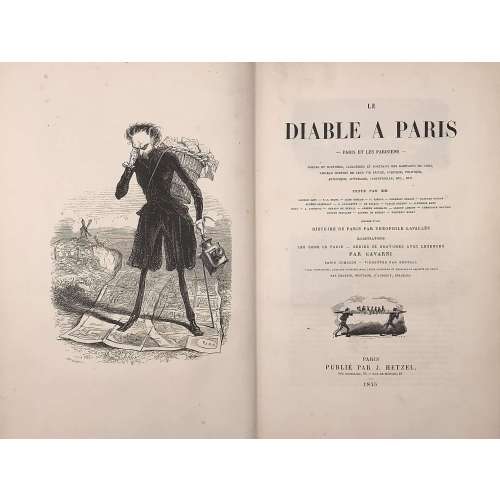
A two-volume set, published in Paris by P.-J. Hetzel in 1845 and 1846.
Vol. 1:
Title: LE | DIABLE A PARIS | — PARIS ET LES PARISIENS — | MŒURS ET COUTUMES, CARACTERES ET PORTRAITS DES HABITANTS DE PARIS, | TABLEAU COMPLET DE LEUR VIE PRIVEE, PUBLIQUE, POLITIQUE, | ARTISTIQUE, LITTERAIRE, INDUSTRIELLE, ETC., ETC. | TEXTE PAR MM. | GEORGE SAND — P.-J. STAHL — LEON GOZLAN — P. PASCAL — FREDERIC SOULIE — CHARLES NODIER | EUGENE BRIFFAULT — S. LAVALETTE — DE BALZAC — TAXILE DELORD — ALPHONSE KARR | MÉRY — A. JUNCETIS — GERARD DE NERVAL — ARSÈNE HOUSSAYE — ALBERT AUBERT — THÉOPHILE GAUTIER | OCTAVE FEUILLET — ALFRED DE MUSSET — FRÉDÉRIC BÉRAT | précédé d’une | HISTOIRE DE PARIS PAR THEOPHILE LAVALLÉE | ILLUSTRATIONS | LES GENS DE PARIS — SERIES DE GRAVURES AVEC LEGENDES | PAR GAVARNI | PARIS COMIQUE — VIGNETTES DE BERTALL | VUES, MONUMENTS, EDIFICES PARTICULIERS, LIEUX CÉLÈBRES ET PRINCIPAUX ASPECTS DE PARIS | PAR CHAMPIN, BERTRAND, D’AUBIGNY, FRANÇAIS. | [DEVICE] | PARIS | PUBLIÉ PAR J. HETZEL, | RUE RICHELIEU, 76 – RUE DE MÉNARS, 10. | 1845 ||
Pagination: ffl, [2 – h.t. / Paris: Typographie Lacrampe et Comp., Rue Damiette, 2 ; Papeir de la fabrique de sainte-marie] [2 – blank / frontis. ‘Diable’ with lantern standing on map of Paris] [2 – t.p. /blank] [I] II-XXXII, [1] 2-380, bfl. Sheet size: 27.5 x 17.5 cm.
Collation: 4to; A(4) – D(4), [1(4)] 2(4) – 47(4), 48(2); illustrations: frontispiece, vignette title-page, numerous text engravings and 99 plates.
Vol. 2: Title: LE | DIABLE A PARIS | — PARIS ET LES PARISIENS — | MŒURS ET COUTUMES, CARACTERES ET PORTRAITS DES HABITANTS DE PARIS, | TABLEAU COMPLET DE LEUR VIE PRIVEE, PUBLIQUE, POLITIQUE, | ARTISTIQUE, LITTERAIRE, INDUSTRIELLE, ETC., ETC. | TEXTE PAR MM. | DE BALZAC — EUGÈNE SUE — GEORGE SAND — P.-J. STAHL — ALPHONSE KARR | HENRY MONNIER — OCTAVE FEUILLET — DE STENDAHL — LEON GOZLAN — S. LAVALETTE — ARMAND MARRAST | LAURENT-JAN —ÉDOUARD OURLIAC — CHARLES DE BOIGNE — ALTAROCHE — EUG. GUINOT | JULES JANIN — EUGENE BRIFFAULT — AUGUSTE BARBIER — MERQUIS DE VARENNES — ALFRED DE MUSSET | CHARLES NODIER — FRÉDÉRIC BÉRAT — A. LEGOYT| précédé d’une | GÉOGRAPHIE DE PARIS PAR THEOPHILE LAVALLÉE | ILLUSTRATIONS | LES GENS DE PARIS — SERIES DE GRAVURES AVEC LEGENDES | PAR GAVARNI | PARIS COMIQUE — PANTHÉON DU DIABLE A PARIS PAR BERTALL | VUES, MONUMENTS, EDIFICES PARTICULIERS, LIEUX CÉLÈBRES ET PRINCIPAUX ASPECTS DE PARIS | PAR CHAMPIN, BERTRAND, D’AUBIGNY, FRANÇAIS. | [DEVICE] | PARIS | PUBLIÉ PAR J. HETZEL, | RUE RICHELIEU, 76 – RUE DE MÉNARS, 10. | 1846 || Pp. : ffl, [2 – h.t. / Paris: Typographie Lacrampe et Comp., Rue Damiette, 2 ; Papeir de la fabrique de sainte-marie] [2 – t.p. /blank] [I] II-LXXX, [1] 2-364, bfl. Sheet size: 27.5 x 17.5 cm. Collation: 4to; A(4) – I(4) – J(4), 1(4), 2(4) – 45(4), 46(2); illustrations: vignette title-page, numerous text engravings and 112 plates.Binding: [allegedly Roger de Coverly (British, 1831 — 1914)], 28.2 x 19 cm, ¾ brown calf ruled in gilt, brown marbled boards, nonpareil marbled endpapers, raised and ruled in gilt bands, floral devices and title lettering to spine. AEG. Foxing to flyleaves, tips of corners just a very little rubbed as are the glazed marbled paper boards; endpapers foxed; very occasional light scattered foxing of text.
Provenance: (1) Armorial bookplate (Ex Libris Sir John Whittaker Ellis, 1st Baronet (1829 – 1912), Lord Mayor of London 1881; (2) Bookplate Ex Libris Robert Frederick Green) dated 1909.
Reference: L. Carteret (1927) pp. 203-207: the first edition, lacking the publisher's white pictorial wrappers.


